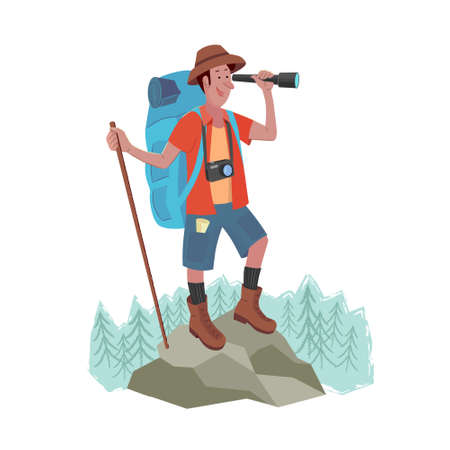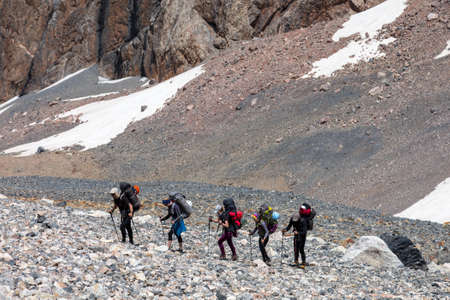1. Introduction: The Importance of Staying Hydrated on Summer Hikes
When it comes to hiking in the American backcountry during the summer, staying hydrated isn’t just a good idea—it’s absolutely essential for your safety and enjoyment. The combination of high temperatures, dry air, and strenuous activity can quickly lead to dehydration, especially in remote areas where water sources are limited or hard to find. Understanding the risks of dehydration helps you prepare better and stay healthy while exploring America’s wild places.
Hikers often underestimate how much water their bodies need, particularly in famous U.S. hiking destinations like the Rockies, Sierra Nevada, or desert regions such as Utah and Arizona. In these locations, the sun is intense, sweat evaporates quickly, and you might not even realize how much fluid you’re losing until it’s too late.
Why Hydration Matters More in Summer Backcountry Hiking
During hot American summers, your body works overtime to keep cool. This means you sweat more than usual, losing not only water but also essential electrolytes. In remote backcountry settings, help may be hours—or days—away if things go wrong. Dehydration can sneak up fast, affecting your energy levels, decision-making skills, and even your heart and kidney function.
Common Risks Associated with Dehydration
| Risk | How It Affects Hikers |
|---|---|
| Heat Exhaustion | Dizziness, headache, nausea; can progress to heat stroke if untreated |
| Cramps & Fatigue | Muscle cramps and sudden tiredness make hiking difficult or dangerous |
| Poor Decision-Making | Dehydration impairs mental sharpness—crucial for navigation and safety |
| Kidney Stress | Lack of fluids strains kidneys, increasing risk of long-term damage |
The Backcountry Challenge
Unlike city parks or popular trails with water fountains along the way, backcountry routes in America often require you to carry all your water or know exactly where reliable sources are found. Wild places like Yellowstone, Yosemite, or the Appalachian Trail can be miles from civilization. If you run out of water or get lost without enough supplies, dehydration risks multiply fast.
By recognizing these dangers early on and understanding why hydration is so important during summer hikes in America’s vast wilderness areas, you’ll be better equipped to plan your adventure safely and enjoy every step along the trail.
2. Recognizing Dehydration: Signs and Symptoms on the Trail
Why Early Detection Matters
When youre hiking in the American backcountry, especially during the hot summer months, dehydration can sneak up faster than youd think. Catching the signs early can make all the difference—helping you stay safe, alert, and able to enjoy your adventure without worry.
Common Physical Signs of Dehydration
| Physical Sign | What It Looks/Feels Like | Why It Matters on the Trail |
|---|---|---|
| Dry Mouth & Cracked Lips | Your mouth feels sticky or dry; lips may split or chap | Makes it hard to eat or talk; early warning sign to drink up |
| Dark Yellow Urine | Pee is much darker than lemonade—think apple juice color or darker | Your bodys holding onto water; its time to hydrate right away |
| Dizziness or Lightheadedness | You feel faint when standing up or hiking uphill | Can lead to falls or accidents, especially on rocky trails |
| Headache | Pounding head, especially under the sun or after a few miles in | May be mistaken for heat exhaustion but often means you need water |
| Lack of Sweat (or Excessive Sweating) | You stop sweating despite activity—or sweat buckets and then suddenly stop | Your body’s not regulating heat well; both are red flags for dehydration and heat illness |
| Muscle Cramps | Sharp pain in your legs, feet, or hands—muscles may seize up unexpectedly | Losing water and electrolytes can cause painful cramps mid-hike |
| Rapid Heartbeat or Breathing | Your heart races even at rest; breathing feels shallow or quick for no reason | Your body’s working harder to cool down and move blood—often due to low fluids |
| Fatigue & Weakness | You feel wiped out, even after a short distance; legs feel heavy like “lead” boots | Dehydration saps your energy fast; makes finishing your hike tough and risky |
Mental and Behavioral Signs to Watch For
| Mental Sign | Description | Trail Impact |
|---|---|---|
| Irritability | You feel unusually grumpy or snap at hiking buddies over small things | Mood swings can signal dehydration before physical symptoms hit |
| Poor Concentration | Trouble reading maps, following trail markers, or remembering simple tasks | Makes navigation mistakes more likely—dangerous in remote areas |
| Confusion | You get disoriented about direction, time, or plans—even on familiar trails | A major red flag that you need water ASAP; can lead to getting lost |
| Lack of Motivation | Suddenly losing interest in continuing the hike or making decisions | If you just want to sit down and quit, check your hydration status first! |
| Poor Coordination | Feeling clumsy—stumbling over rocks, tripping on roots more than usual | This could set you up for injuries if not caught quickly |
Quick Trail Check: Is It Dehydration?
- If you notice two or more symptoms from either table above, it’s smart to take a break, find some shade, and sip water slowly—even if you don’t feel thirsty.
- Remember: Thirst isn’t always the first sign. By the time you’re thirsty on a hot American trail, dehydration may already have set in.
- If symptoms persist even after hydrating, consider heading back to camp or seeking help from fellow hikers.
Stay Proactive: Buddy System & Self-Checks
Keep an eye on each other when hiking with friends—sometimes others will spot changes in your mood or coordination before you do. Make it a habit to ask yourself (and your hiking partner): “When did I last drink? How am I feeling?” every hour. Early recognition can keep a small problem from turning into a serious emergency out on America’s beautiful but unforgiving backcountry trails.

3. Risk Factors: Why the American Backcountry Increases Dehydration Hazards
When you head out for a summer hike in America’s wild backcountry, you’re facing more than just beautiful scenery—you’re also exposed to unique dehydration risks not as common in city parks or local trails. Here’s why:
Climate Differences: Hotter, Drier, and Less Predictable
The American backcountry often features hotter temperatures and lower humidity, especially in regions like the Southwest, Rockies, or high desert. Dry air means your sweat evaporates quickly, making it easy to underestimate how much water you’re losing.
Comparison of Urban vs. Backcountry Hiking Conditions
| Factor | Urban/Suburban Trails | American Backcountry |
|---|---|---|
| Temperature | More moderate, shaded by trees/buildings | Can be extreme—high heat during day, cold at night |
| Humidity | Usually higher due to landscaping/water sources | Often very dry, especially in western states |
| Water Access | Frequent fountains/rest stops | Sparse or seasonal streams; water may need treatment |
| Emergency Help | Quick access (cell service, first responders) | Difficult access; limited cell coverage; long rescue times |
Elevation: Thinner Air and Greater Water Loss
Many popular U.S. hiking spots are at high elevations—think Rocky Mountain National Park or California’s Sierra Nevada. Higher altitudes mean thinner air, which causes you to breathe faster and lose more moisture through respiration. This increases your risk of dehydration even if you don’t feel extra sweaty.
Remoteness: Scarce Resources and Greater Consequences
The farther you venture from civilization, the less likely you’ll find reliable water sources. Lakes and streams might be dry or unsafe to drink without proper filtration. If you run out of water, help could be hours—or days—away.
Why Remoteness Matters:
- No quick fixes: You can’t just pop into a convenience store for a bottle of water.
- Poor cell signal: Calling for help might not be possible.
- Tough terrain: Injuries or fatigue can slow you down, using up more fluids as you struggle to get back to safety.
Key Takeaway:
The combination of hot and dry climate, high elevation, and the remote nature of many American backcountry trails means hikers must plan ahead and carry enough water—and know how to find and purify more if needed—to avoid serious dehydration risks.
4. Practical Prevention: Hydration Strategies for U.S. Backcountry Hikers
How Much Water Do You Really Need?
When hiking in the American backcountry during summer, staying hydrated is essential. A good rule of thumb is to drink about half a liter (16-17 oz) of water per hour during moderate activity in moderate temperatures. In hotter conditions or with higher exertion, you may need up to one liter (32 oz) per hour. Heres a quick reference guide:
| Condition | Recommended Water Intake (per hour) |
|---|---|
| Moderate temps, easy hike | 0.5 liters (16-17 oz) |
| Hot weather, strenuous hike | 1 liter (32 oz) |
| Very hot/dry climates | 1-1.5 liters (32-50 oz) |
Top Hydration Gear Among American Hikers
The right gear can make a big difference on the trail. Here are some favorites commonly used by U.S. hikers:
- Hydration Bladders (CamelBak, Osprey): Easy to sip from without stopping.
- Nalgene Bottles: Durable, lightweight, and wide-mouthed for easy filling.
- Sawyer Squeeze or LifeStraw Filters: Popular portable water filtration options for refilling from streams and lakes.
- Electrolyte Tablets or Powders (Nuun, Liquid I.V.): Helps replace lost salts and minerals.
Smart Planning for Longer Hikes
Know Your Route and Water Sources
Before heading out, research your trail using American resources like AllTrails or local National Park Service maps. Note reliable water sources along the way and plan accordingly. Don’t assume that every stream is safe—always treat or filter water in the backcountry.
Packing Enough Water: A Quick Formula
If you’re hiking a 6-hour trail in moderate heat, you’ll need at least 3 liters (about 100 oz) of water per person, more if it’s hotter or you sweat heavily.
| Total Hiking Hours | Suggested Minimum Water (per person) |
|---|---|
| 2 hours | 1 liter (34 oz) |
| 4 hours | 2 liters (68 oz) |
| 6 hours+ | 3+ liters (100+ oz) |
Culturally Relevant Tips from U.S. Outdoor Pros
- “Camel up” at water sources: Drink plenty before leaving camp or a stream to reduce what you have to carry.
- Avoid peak heat hours: Start early and take breaks in the shade between 11 am and 3 pm when possible.
- Add electrolytes: Americans often carry electrolyte mixes—don’t just drink plain water for long stretches.
- Pace yourself: Slow down if you feel thirsty, dizzy, or fatigued; dehydration can creep up quickly in U.S. summer conditions.
- Treat all backcountry water: Even clear mountain streams can carry harmful bacteria or protozoa.
Your Quick Hydration Checklist for Summer Hikes in America:
- Packed enough water + filter or purifier?
- Brought electrolyte mix/tablets?
- Knew where to refill safely?
- Dressed for sun protection?
- Told someone your route?
Staying hydrated on the trail isn’t just about drinking more—it’s about smart planning, choosing the right gear, and understanding your body’s needs under the hot American sun. Use these strategies to help ensure your next backcountry adventure is safe and enjoyable!
5. Emergency Responses: What to Do if You or a Buddy Are Dehydrated
Recognizing a Dehydration Emergency
When hiking in the American backcountry during summer, dehydration can quickly become an emergency. Its important to spot the warning signs early. Watch for these common symptoms:
| Early Signs | Serious Signs |
|---|---|
| Thirst Dry mouth Dark yellow urine Headache |
Dizziness Confusion No sweating Rapid heartbeat Lack of urination Fainting |
Step-by-Step Actions for Dehydration Emergencies
Step 1: Stop and Seek Shade
If you or your buddy show signs of serious dehydration, stop hiking immediately. Find shade or create some with gear to avoid further heat exposure.
Step 2: Cool Down
Sit or lie down. Remove unnecessary clothing and loosen anything tight. Use a hat or bandana soaked in water to cool the head, neck, and wrists.
Step 3: Hydrate Carefully
If the person is alert and able to drink, give them small sips of water every few minutes. If available, use an electrolyte solution (like sports drinks or rehydration tablets) instead of plain water for better recovery.
Step 4: Monitor Symptoms
Keep a close eye on symptoms. If they worsen—such as confusion, vomiting, or inability to keep fluids down—it’s time to call for help.
How to Get Help in the Backcountry (U.S. Standards)
| Situation | What To Do |
|---|---|
| No Cell Service | Use a satellite messenger or personal locator beacon (PLB). Send an SOS message with your GPS location. |
| Cell Service Available | Call 911. Explain your location using trail names, mile markers, or GPS coordinates. Stay put unless it’s unsafe. |
| No Emergency Device/Service | If safe, send two people (never one) for help while someone stays with the dehydrated hiker. Mark your route clearly for rescuers. |
Key Tips from U.S. Outdoor Safety Guidelines
- Never leave someone alone who is ill or confused.
- Avoid giving large amounts of water at once; slow and steady is safer.
- If unconscious or unable to swallow, do not give fluids—seek rescue immediately.
- Cary a first aid kit with oral rehydration salts on every trip.
- Pace yourself and rest often during hot weather hikes.


